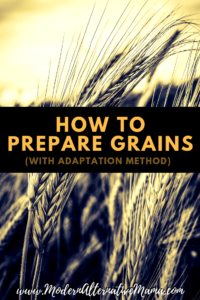Written by Kate Tietje and updated by Sarena-Rae Santos in November of 2023.
We’ve discussed grains being good or bad and why we want to prepare grains by sprouting, soaking, or souring. But how do we do this? What about recipes we already use– how do we adapt them? Let’s discuss it!
Sourdough
I’m starting with this because it’s not my specialty, and I don’t have much to say about it. Souring is supposed to be the best way to prepare grains because it’s long, slow fermenting and can be used for both “yeasted” bread and quick bread. It’s actually quite versatile!
Check out our blogs, How to Make a Sourdough Starter, Perfect Sourdough Bread, and Gluten-Free Sourdough Boule, to learn more about the art of sourdough.
Sprouting Grains
This method I know a lot more about. I’ve been experimenting with sprouted grains since 2009 or 2010.
Sprouting grains is simple. I won’t discuss it here because I already have a How to Sprout Grains Tutorial, so I’ll refer you there. Sprouting changes the grain dynamically and makes it safer.
I also have tips on baking with sprouted grains.
Generally, you can substitute sprouted grain flour 1:1 with any other flour in a recipe. However, the result may be a bit heavier than you are used to since the flour lacks gluten. It does better in quick bread recipes than yeast since you don’t want to develop the gluten in quick bread recipes anyway. That’s typically how I use sprouted grains now — quick breads.
Soaking Grains
I’ve been experimenting with this for years, and that is why I have begun to prefer yeasted bread. Soaking grains helps decrease the phytic acid, making the grains more digestible.
Recent research shows that any dairy-based mediums (whey, buttermilk, yogurt, kefir, etc.) are not recommended because their high calcium content inhibits the breakdown of phytic acid. As per Nourishing Traditions, many recipes call for this, but research doesn’t agree.
Instead, using plain warm water will help to break down the phytic acid more effectively. I previously used lemon juice in all my soaking, which worked well for me. Science has since changed, and I no longer recommend an acidic soaking environment, which I discuss in our blog, How to Soak Rice. When a recipe simply calls for a couple of tablespoons of acidic medium, simply swap out a dairy-based culture for lemon juice.
What if a recipe calls for buttermilk as the main liquid, as well as for soaking? Honestly, I don’t have a good solution for this yet, and I would recommend finding another recipe. This isn’t usually a problem with yeasted breads, which is why they are easier (in my opinion) to soak. You could swap the regular flour for sprouted and use the buttermilk without soaking, of course.
How do you adapt a recipe to soak?
- Put in all the liquid ingredients (except eggs) — honey, butter, coconut oil, etc.
- Add water and 1 tbsp. lemon juice per cup (or skip the lemon juice if it might add a weird flavor, as with oats).
- Do NOT add eggs, salt, or high-calcium foods.
A perfect example is my soaked whole grain bread recipe.
I played with this recipe a lot before I was satisfied. But I figured out that yeast doesn’t need to proof (I regularly bake at least 3 different soaked bread recipes with regular active dry yeast, and never proof it, and never have a problem). I don’t need scalded milk because the purpose is to soften the bread, which the soaking takes care of.
Learning to adapt recipes takes a little practice, but it is possible in many cases. If in doubt, though, search for “soaked _____” and use a recipe with soaking directions already!
Are you ready to take the next step and prepare grains by soaking, sprouting, or souring?



Should I soak buckwheat oats before grinding them? If so , do I dry them first? I'm confused.
When do you knead the bread dough? Before the overnight soaking or after?
After you soak and add the additional ingredients. 🙂
Can you use vinegar/apple cider vinegar instead of lemon juice?
Yes, that should be fine.
Would you ever want to sprout grains, grind them, and then soak them? Or is it a one-or-the-other thing?
Usually it is one or the other. If you do both, the gluten breaks down too much and the resulting product is heavy and mushy and not so good.
Can you please provide your sources regarding dairy based soaking mediums.
Thanks
Matt
I’m very happy to uncover this site. I need to to thank you for ones time
just for this wonderful read!! I definitely enjoyed
every little bit of it and i also have you bookmarked to check out
new stuff in your website.